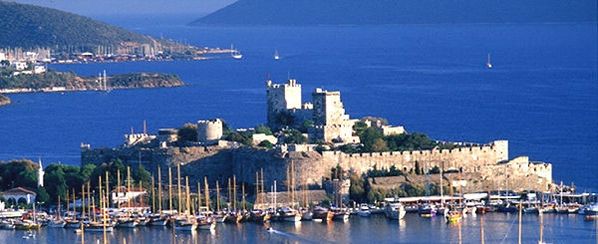PLANS that could see the famous shipwrecks of the Museum of Underwater Archaeology relocated within Bodrum Castle and the Knights Chapel restored to a mosque for worship has stirred debate.
Under government plans, the chapel, which hosts some of the great treasures of St Peter’s Castle, could be converted back to a mosque as it was back in the days of the Ottomans.
The very thought of even relocating the shipwrecks have stirred debate particularly as the Castle has been on UNESCO’s tentative world heritage list since 1995. The chapel has been used as the main exhibition hall since the 1970s.
The plan, which is being overseen by the Culture and Tourism Ministry, foresees 18 months of works.
The 30 million TL project, slated to begin in October, will see changes to the North Moat, as well as changes to areas around the cafeteria, shop, glass sunken lounge in the castle’s interior, the coin and jewellery store, the Amphora Exhibition Hall, the Bronze Age Shipwrecks Hall, Carian Princess Hall, and other attractions. As yet, no alternative sites have been revealed for all these historic treasures.
The Knights Hall exhibition space may be given over to public worship as a mosque. The chapel was converted into a mosque by Sultan Suleyman the Magnificent in 1523.
Aykut Ozet, who served the museum for 25 years, reacted: “As a former employee and manager of the Bodrum Museum of Underwater Archaeology, I oppose the destruction of the castle which is the pride of the Turkish museums.”
Archaeologist and professional tour guide Canan Kucukeren commented: “Why destroy a historical place that has been recognised across the world and which brings in thousands of dollars to Turkey? Surely, this will cause physical damage to the castle and it will be closed for months.”
Bodrum Castle and the Museum of Underwater Archaeology (from Lonely Planet)
The castle was built by the Knights Templar in the early 15th century and dedicated to St Peter. Today it houses the Museum of Underwater Archaeology (Sualtı Arkeoloji Müzesi), arguably the most important museum of its type in the world.
Based on Rhodes, the Knights built the castle during Tamerlane’s Mongol invasion of Anatolia in 1402, which weakened the Ottomans and gave the order an opportunity to establish a foothold here.
They used marble and stones from Mausolus’ famed Mausoleum, which had collapsed in an earthquake, and changed the city’s name from Halicarnassus to Petronium, recalling St Peter. By 1437 they had finished building, although they added new defensive features (moats, walls, cisterns etc) right up until 1522, when Süleyman the Magnificent captured Rhodes.
The Knights were forced to cede the castle, and the victorious Muslim sultan promptly turned the chapel into a mosque, complete with new minaret. For centuries, the castle was never tested, but French shelling in WWI toppled the minaret (re-erected in 1997).
On the east side of the courtyard is the chapel (1406) containing a full-sized reconstruction of a late-Roman ship’s stern that sank off Yassıada in AD 626.
Climbing towards the towers to the east, you next come to the Glass Wreck Hall on the left. It houses a 15m-long, 5m-wide ship that sank near Marmaris in AD 1025, while carrying 30 tonnes of glass between Fatimid Syria and a Byzantine glass factory on the Black Sea or the Danube.
A Glass Hall exhibits finds from the 15th century BC to the 14th century AD, and includes Mycenaean beads, Roman glass bottles and Islamic weights.
The French Tower has finds from the Tektaş Burnu, the world’s only fully excavated classical Greek shipwreck (dating from 480 BC to 400 BC). Amphorae, talismanic marble discs and kitchen utensils from the vessel are displayed, plus 2001 excavation photos taken at the Çesme Peninsula site. Ancient coins (including from Croesus’ Caria) and jewellery are also on display.
The neighbouring Carian Princess Hall is a must-see, exhibiting a gold crown, necklace, bracelets, rings and an exquisite wreath of golden myrtle leaves. Popularly associated with the last Carian queen, Ada (Mausolus’ sister who was reinstated by Alexander the Great after annexing Halicarnassus in 334 BC), they belonged to an unknown woman of status whose skeleton was found in the heavy terracotta sarcophagus on display here.
The Bronze Age Shipwrecks Hall contains three Bronze Age shipwrecks, including the world’s oldest excavated wreck, the14th-century BC Uluburun, which sank 8km off the coast near Kaș. Full-size replicas of the booty-laden hold and the wreck site on the sea floor are in place.
The adjoining Treasure Room displays Canaanite gold jewellery, bronze daggers, ivory cosmetic boxes, wooden writing boards and Egyptian Queen Nefertiti’s golden scarab found on a wreck and already several hundred years old by then.
